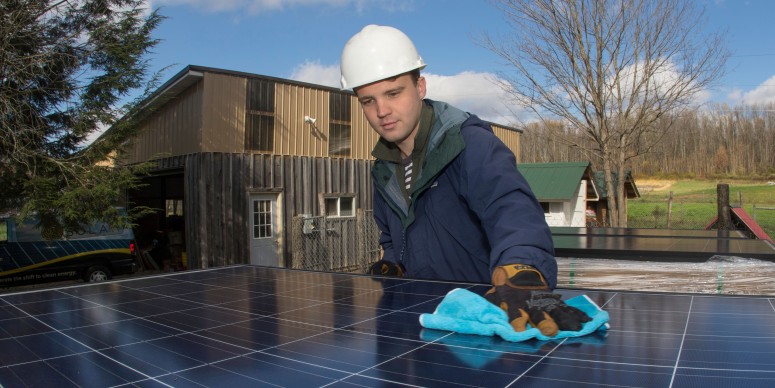Powering Up

From Kenyon News - November 11, 2015
When the shiny black solar panels were hoisted and secured to the barn at the Kenyon Farm at the end of October, it was a major step toward solar power at the College — the first of many.
“We’ve been looking at solar power for the last five or six years,” said Mark Kohlman, chief business officer. “This was the right type of project for Kenyon.”
Jerry Kelly ’96, a consultant with Third Sun Solar in Athens, Ohio, approached Kohlman at the end of last semester. He proposed converting the Kenyon Farm to partial solar power and building an independent study class around the project. Eric Holdener, assistant professor of physics and scientific computing, managed the curriculum, while Kelly worked with Third Sun Solar on the installation. The students participated in the entire process for class credit and experience, and the Farm ultimately will receive 85 percent of its power from the sun.
“When we had originally looked at solar power five years ago, we were asking how do we offset the total amount of campus usage. That’s a big project,” Kelly said. “Now we’re looking at using some smaller projects as a centerpiece for experiential learning.”
Four students in the class have been learning everything from essential electricity basics and solar electric design to the necessary financial analysis of such endeavors.
“Financial engineering is probably the biggest challenge to a successful project right now,” said Zach Sawicki ’16 of Howard, Ohio. “It’s easy to plan a system, but it’s not so easy to figure out how to pay for it.”
Sawicki, a political science major, says he’s passionate about renewable energy and has worked as an intern for Community Renewable Energy in Columbus for the last two years. Most of his work was research on state and federal government policies. This course taught him the actual fundamentals of solar power.
“I think we’re at an interesting time where the energy paradigm as we know it is completely shifting,” Sawicki said. “The Kenyon Farm is now its own power station. That’s something that I’m an advocate of, so the best part is seeing it in action.”
Jordan Meier ’16, an economics major from Syracuse, New York, said the course has been a good change of pace from her economics classes. “To be able to go in and get some physics and some real hands-on experience, it’s been awesome. We’re really getting a good glimpse of solar, which is such an up-and-coming thing.”
Meier is planning to use what she has learned to help install solar panels at schools in Belize over spring break.
Solar power at the farm was switched on at 4 p.m. Dec. 11, in a public event. The energy produced is monitored through a website. The entire project cost $56,000.
The independent study course has gone so well, the College is making it a special topics course in physics next semester. The College’s long-term plan is to get 10 to 15 small solar-powered systems up and running the next 10 years, but there’s a more immediate short-term objective, too.
“The goal is to have it become a permanent course, not an independent study, and to give students real-life experience,” Kohlman said.